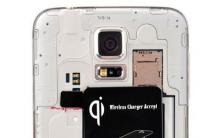The method of charging gadgets without direct contact with wires is becoming more and more firmly in our lives.
It is no longer necessary to regularly wire the phone to the socket. It is enough to place it on a special surface, and the battery will start receiving power.
How does wireless charging work?
Wireless chargers are based on a physical phenomenon such as magnetic induction, which allows electricity to be transferred over a distance from one induction coil to another.
The main part of such a device is a charging station, which is a primary coil in a plastic case. It is connected to an electrical outlet, after which an electromagnetic field is created at a short distance around it. A smartphone equipped with a secondary receiver coil is placed on the charging station and begins to receive electricity to power the battery.
What is Qi?
In theory, wireless charging can be implemented in different ways, so the characteristics of the charging station may vary. This means that a wireless charger from one smartphone may not work with a smartphone from another manufacturer.
To avoid this, global electronics manufacturers have joined together in the Wireless Electromagnetic Energy Consortium and adopted a single standard called Qi. In Russian it reads as "Qi". It is within this standard that most wireless chargers and phones are manufactured.

The maximum power of wireless chargers is 5W with a current of 1A. This is enough to successfully charge the smartphone battery. The efficiency of such chargers is slightly lower than in those that operate from outlets, so it will take a little more time to reach 100% charge.
On top smartphones of well-known brands, such as Samsung and iPhone, the receiver (receiving coil) is installed at the production stage, and this does not affect the thickness of the gadgets - they remain thin.
DIY wireless charging
If the manufacturer did not initially provide for wireless charging, then using a special adapter, you can fill this gap. There are special films with an induction coil on sale, which are selected depending on the smartphone model. They can be installed under its cover. In this case, the connection is made through the contacts provided for this.

It is also possible to place the coil between the back cover and the case, and a special cable from it is installed into the power connector. The thickness of such a film-receiver is about 2 mm, so the external gadget will practically not change.
In terms of intensity, the electromagnetic radiation from the charging station is lower when compared with the cellular signal. When the battery reaches 100% charge, the power controller turns off the induction field. Therefore, users should not fear for their health - such a charger will not cause any harm.
Where to charge over the air?
Wireless battery charging is gaining acceptance. Special podiums for wireless charging appear in cinemas, cafes, airports. Thanks to a single standard, they can recharge any phones that support Qi.

Manufacturers of interior elements successfully install charging stations in tables, armchairs, table lamps. In new car models, engineers have provided special podiums in the dashboard on which you can place your smartphone for charging. Moreover, now there is no need to purchase cigarette lighter chargers for the car, which saves the user from unnecessary wires.
A technology has now become available that allows phones to be charged without using a cable. Its advantage is that this procedure is faster and easier, and you do not have to connect your smartphone to the network every time - you just need to place the device on top of the wireless charging pad.
There are various competing standards for this technology. The most popular of these is Qi, which is now supported by companies like Samsung, Google and Nokia. However, more and more manufacturers are starting to use it in one form or another.
Which phones support wireless charging?
Some smartphone models have a built-in wireless charging function (their rating is presented below). Other devices will need to replace the back cover or case for this. Qi accessories are tailor-made for specific phones, so if you connect them yourself, make sure you select a compatible model.
If a dedicated wireless charging cover is not available for your smartphone, you can use a universal adapter that allows you to use this technology even for older devices.
What do you need to know about wireless charging?
As noted above, the Qi standard is currently in the lead, which is now used in most Android devices. The technology works by using magnetic induction to transfer energy from the platform to the phone's battery. The Qi standard, whose name in Chinese means "air" or "flow of spiritual energy", was created in 2008 and began to be developed simultaneously with the participation of 206 companies, including Microsoft, Samsung and Sony.

Speaking about which devices support wireless charging, the less common PMA standard should also be remembered. It also works by magnetic induction, but its area of \u200b\u200bdistribution is somewhat lower. In June 2014, PMA developers partnered with Duracell to place charging platforms in select public areas in the US to promote the technology. If this idea turns out to be viable in the long run, it is possible that more smartphone manufacturers will start using the standard.
If we talk about which phone models support Qi-standard wireless charging, then the choice will be very large. Even if your Android smartphone does not have this technology built in, you can get the universal Qi receiver, which costs only about $ 15. Despite its cumbersomeness, it will add essential convenience to you when using the gadget. The device attaches to the back of your device, which can then be placed on any Qi-compatible charging platform. Regarding which phones support Qi wireless charging, it is worth noting that there is a receiver for the iPhone (models 5, 5s and 6) that is also receiving positive reviews. Its cost is about $ 30.

Which phones support wireless charging (list of gadgets)
Those interested in the new technology will find it useful to know the rating of devices that have built-in Qi standards.
The most famous model in this regard is which is currently available for about $ 200. According to user reviews, this is one of the best Android devices in general. Also, this device is the leader in the use of wireless charging. The smartphone is compatible with both Qi and PMA technologies. Thanks to its sleek design, good speed and large 16MP camera, this phone outperforms the iPhone in some ways. The commercially available Qi charger has a good long power cable. Its edges glow with a light blue tint during charging and turn green when charging is complete.
Devices that can charge wirelessly include the following:
- Samsung Galaxy Note Edge.
- Samsung Galaxy Note 4.
- Google Nexus 6.
- Motorola Droid Turbo and others.
Other Samsung models
Analyzing which Samsung phones support wireless charging, one cannot but recall this model also simultaneously supports both Qi and PMA standards. An attractive curved design and a user-friendly display give wearers instant access to messages and other important data, while the built-in adapter does not degrade user experience in the least. If the gadget itself can be purchased for about $ 300, the Pad charging device will cost about $ 40.
Also belongs to this category of devices. This smartphone with an innovative curved screen offers very strong graphics performance on a bright display. Its screen size is significantly larger than that of other devices, so the battery consumption is correspondingly faster. This model does not integrate wireless charging directly into the back of the phone, but there is a special Samsung cover with Qi support that replaces the standard back of the device. This component costs approximately $ 25 and is available in two colors: Charcoal Black and Snow White.

If you ask which phones support wireless charging in general, you will notice that this technology affects mainly gadgets with high hardware capacities, for which the ability to quickly charge them is especially important.
Based on this, it is completely not surprising that it is also equipped with the described technology. This gadget features high multitasking, fast and high-quality camera and high brightness of the screen measuring 5.7 inches. In order to wirelessly charge it, you need a special case. It is available for about $ 30 and comes in two colors.
At the same time, Samsung is not the only manufacturer that uses this technology in large quantities. What other brands of phones support wireless charging? Consider below.
Other brands
Google Nexus 6 has a nearly 6-inch screen and is equipped with a high-power processor, so it especially needs fast and efficient charging. Qi technology is built in here from the very beginning, so there is no need to buy an additional cover or case. This gadget is quite expensive - about $ 500, but amateurs highly appreciate its hardware power along with Android 5.0. All this offers users a high level of comfort. Despite the fact that there is no dedicated platform for wireless charging, the universal component will do its job perfectly.

Speaking of which phones support wireless charging, we can't help but mention a model like the Motorola Droid Turbo. This smartphone with a screen of just over 5 inches has a 21MP camera and many built-in functions. Its battery lasts approximately 9 hours with active use, so the built-in Qi technology is very useful. There is also a dedicated charger for this model, which places the phone in an upright position. This means you can continue to use the device while charging.
Sony brand
As already noted, the most active new technology is used by manufacturers such as Samsung, Google and Sony. Which Sony phones support wireless charging? First of all, this is the Sony Xperia Z3 - a waterproof gadget that, with active use, lasts up to 12 hours without recharging. Its screen is high brightness and its speakers provide loud, chic acoustics. Despite the fact that it costs about $ 400, the device is very popular. The wireless charging cover will have to be purchased separately and costs over a hundred dollars.

Can I adapt my smartphone?
Which phones support wireless charging without built-in technology? If your device does not have native Qi support, you can separately purchase and install an adapter and use the wireless universal charger. Depending on the brand of the gadget, you can connect the adapter via the micro-USB port (on the Android platform) or "lightning" (on the iPhone).
Universal wireless charging adapters
If your phone is not listed above, then you need a universal adapter and a wireless charger. You can get them for phones with micro-USB ports (like Android) and lightning ports (like iPhone). In this way, you can update and improve almost all devices on sale. If we talk about, for example, which Xiaomi phones support wireless charging, then with the above method, you will be able to charge even a 5-year-old model without a cable.
Universal charger
Once you have made sure that your phone supports wireless charging (by built-in functionality, using a special cover or by connecting an adapter - it doesn't matter), you need to purchase a wireless charger.

There are currently many such Qi devices available in various sizes, shapes and colors. You can buy such a component not only for use at home or in the office, but also for a car, and even a portable Qi battery. If you have purchased a smartphone that supports wireless charging, it is advisable to choose a charger specially designed for it. If you do not have one, or you have updated your gadget yourself, finding a universal device will not be difficult.
Qi is the Chinese word for “flow of energy” (pronounced chi in English) and is the universal standard for batteries such as iPods, cell phones, and cameras.
Power transmission occurs due to the fact that the receiver receives energy not through a traditional cable, but in a contactless way, thanks to the use of electromagnetic fields. The principle is very simple: the Qi transmitter, which is the base station, directs the necessary energy to the receiver.
Description of technology
The Qi wireless charging standard is based on magnetic induction between the flat coils of the transmitter and receiver. The primary and secondary windings form two pieces of a heartless charger circuitry shielded on the lower surface of the primary and the upper secondary coil. This, as well as the proximity, ensures acceptable power transmission efficiency. Moreover, it minimizes the exposure of users to the magnetic field.
Typically, the base station has a flat surface on which one or more mobile devices can be placed. This ensures that the vertical distance between the primary and secondary windings is small enough. In addition, there are two ways to align the windings horizontally.
In the first case, the user independently sets the secondary winding opposite the primary on the interface surface using the prompts of the mobile device.
The second method, called free positioning, does not require active human participation. In one implementation, several primary windings are created for this. Another option uses mechanical means to move the primary coil under the secondary.
Structural elements
The power transmitter consists of two main functional units, namely a power conversion unit and a communication and control unit. The element of the first, generating a magnetic field, is the primary coil. The second changes the transmitted power to the level requested by the receiver. In addition, the base station may contain more than one transmitter to serve multiple mobile devices, since one primary coil communicates with only one secondary coil at the same time. Finally, the system unit provides power and controls the operation of multiple transmitters.
The gadget contains an energy receiving unit, which is a secondary winding, and a communication and control unit. The latter adjusts the transmitted power to a level acceptable to the subsystem connected to the receiver's power output. An example of such a subsystem is a storage battery.
Communication stages
After activating the communication and control unit of the transmitter, it sends a signal to the receiver to receive a response confirming the presence of a Q-compatible device.
Upon receipt of the request, the receiver enters the selection phase. If the suggested voltage is high enough, then the ping phase begins.
Upon receiving a response from the transmitter, the mobile device sends a signal strength packet and enters the identification and configuration phase, or sends a power transmission complete packet and remains in the ping phase.
An identification packet and management packets are then sent. The receiver enters the charging phase. At the same time, it controls the transmission of energy by transmitting control packets to the base station, which contain information on the adjustment of the primary winding current, on the received energy, on the charging status, on the completion of the transmission.

What is a Wireless Charging Point?
Qi charging is universal because it provides compatibility between mobile phones and different manufacturers. The only condition is that both parts - the transmitter and the receiver - must comply with the Qi standard.
Thus, any Qi wireless charger will fit any Qi mobile receiver, regardless of make and model. Many cell phones from different manufacturers, including Samsung, Nokia, LG, Sony, HTC and Motorola, are already Qi-compliant and therefore can be connected to any charging station that meets its requirements. The number of compatible gadgets continues to grow as more and more companies support wireless power transmission technology. This allows battery-powered electronics to be charged with a single power source.

How it works?
The mobile charger is not the newest invention. Inductive power has been used in electric toothbrushes for many years. The process uses the resonant inductive coupling of the base station transmitter and the mobile phone receiver. The primary coil constantly sends a test signal to the sender to check for a change in capacitance or resonance, indicating the presence of a compatible phone. The transmitter modulates the charge and checks if the Qi wireless charging standard is supported.
Once compatibility and energy requirements have been taken into account, the process of inductive energy transfer begins. In this case, contact between the receiver and the transmitter is maintained. Once the battery is fully charged, they will go into standby mode. Charging universal is activated and transfers energy only if the connected gadget is on it.
The power transmitting and receiving coils are specially shielded to reduce electromagnetic radiation.

The main features of the technology
- A method of contactless transmission of power from a base station to a mobile device, which relies on near-field magnetic flux density between coils.
- Transfer about 5 watts of power using a suitable secondary coil (having a typical external dimension of about 40 mm).
- Work at frequencies from 100 to 205 kHz.
- Support for two methods of placement on the base station surface:
- guided positioning, where a user is assisted in correctly positioning a mobile device in a location that provides power through one or more fixed points;
- arbitrary placement on the surface of the charging station.
- Simple one that allows your phone or tablet to guide the process.
- Considerable design flexibility for integrating the system into a mobile device.
- Low standby power consumption (depending on implementation).

One for all
How convenient would it be to have one Qi charger for all phones, music players, cameras without a lot of tangled cables?
As countless new smartphones sweep the world, battery life is getting shorter. And every manufacturer and even every gadget has its own charger. And with each purchase, their number increases. Ultimately, the user is lost in a pile of various power adapters. Thanks to Q-technology, they become unnecessary, and tangled cables disappear, and these are far from all the advantages of this technology.
Just as Wi-Fi has become the global standard for wireless Internet connections, and Bluetooth has eliminated the need to hold a phone in your hand, so Qi is becoming the global standard for inductive charging of gadgets with batteries.

Is electromagnetic radiation harmful?
Experts were divided. On the one hand, many scientists confirm that a small amount of electromagnetic radiation from wireless charging is not harmful. Others talk about the great danger to which the human body is exposed.
So how much electromagnetic energy is emitted by the Qi system? Very little. The Qi principle has been applied in electric toothbrushes for many years without affecting human health. The charger circuit is such that, due to the small area of \u200b\u200bits action, electromagnetic radiation is extremely limited. It exists only in the immediate vicinity of the wireless transmitting station and only when the gadget is on it. Electromagnetic radiation is further reduced by additional shielding in the transmit and receive coils.

Wireless Power Consortium
The Wireless Power Consortium (WPC) was founded on December 17, 2008. At the same time, a unified program for the development of this technology was approved.
The Qi wireless charging standard ensures its versatility for all Qi-compatible electronic gadgets. This means that every device compatible with it can be charged at any Qi-compatible station. WPS has 250 members including market leaders Samsung, Nokia, LG, Panasonic, HTC, Sony, Microsoft and Motorola, making it the largest alliance of manufacturers supporting wireless charger types.
With the increasing number of products using Qi, it is important to ensure that each mobile charger works correctly with all supported Qi gadgets, says WPC Chairman Menno Treffers. This is facilitated by a constantly updated database created by Testronic, which makes it easy to determine if a new product will be compatible with previously certified products. Qi wireless charging standard has become one of the most important technical developments for phone and tablet users, which are now used daily in work and life.
how to quickly charge Galaxy S7 and S7 edge on wireless charging [updated 04/03/2016]
Wireless Qi-chargers for the most part give out a standard 1 amp load (voltage of 5 volts).
However, smartphones are already equipped with built-in charging systems capable of accepting large loads (up to 1.4 amperes, according to Samsung), thanks to which they can be charged from a wireless charger one and a half times faster than other smartphones.
However, only on condition that they will be connected to the so-called, that is, one that is capable of providing an output of 1.4 amperes. The S7 and S7 edge are also charged from the usual ampere charging at the usual speed.
It is known that Sansung has already begun to produce Wireless Charging Stand models that support such "fast" charging, and in which, by the way, the smartphone is placed not horizontally, but vertically, so that it is much more convenient to use it during charging.
These new Qi-chargers have already gone on sale. As for prices, according to preliminary data, the Wireless Charging Stand will retail for about $ 80.
Here is a short video - for clarity (in the settings you can turn on the translation of subtitles, which "in general terms understand what the foreigner is talking about"):
what is Qi wireless charging?
In short, “Qi” (that's how the word Qi is pronounced) is the world standard for rechargeable batteries for consumer-grade mobile devices. Qi allows wireless charging of compatible devices' batteries using inductive energy transfer. Simply put, you simply place your smartphone on a dedicated transmitter plate without having to plug it into an outlet via a power supply or via a cable to your computer's USB port.
where is Qi wireless charging used?
Today, this technology, like Wi-Fi, is widely used in hotels, airports, train stations and other public places. In addition, Qi charging is also available in the form of inexpensive and compact devices designed for use in the home or office. Like, for example, EC Technology's ultra-thin wireless charger, which costs $ 21 on Amazon.
can i use Qi?
Yes. If your smartphone has support for Qi technology, then any wireless Qi charger is suitable for you. Moreover, it is not necessary to spend only on expensive models, which are recommended by the manufacturer of your smartphone as an official accessory. Any high-quality Qi charger from so-called third-party brands is also suitable.
What is the Qi charging power?
The low-power Qi wireless charger is capable of delivering up to 5 watts of power at a distance of up to 4 cm (in theory), and the medium-power model up to 120 watts. In practice, the aforementioned Qi charging EC Technology can charge the Nokia Lumia 735 smartphone, which is located no more than 2 cm above the transmitter. Therefore, the best option is when both devices are in direct contact with each other.
How fast is Qi wireless charging capable of charging a smartphone or tablet battery?
As a rule, smartphones, and especially tablets, charge noticeably more slowly through a wireless Qi charger than through conventional chargers. For example, EC Technology Qi charging supports a current of 1A, which is enough to recharge the smartphone battery at a normal pace, but not enough to quickly charge the battery of the Nexus 7 tablet, whose standard charger produces 2A.
qi wireless charging: how to use it?
Step 1 ... We plug the Qi charger into an outlet (yes, it charges wirelessly, but it works from the mains) or connect it to the USB port (for EC Technology, the USB cable is included in the delivery set) of a computer, tablet or external mobile battery.
Step 2 ... First, let's check again if our smartphone (or tablet) supports Qi wireless charging technology. The data can be found in the model specification. On smartphones with removable back panels, Qi system elements can be seen on the back of the lid. In addition, some manufacturers produce Qi adapters for models in which Qi charging is not supported initially. For example, for its Galaxy S4, Samsung has developed a Qi back cover that can be replaced with a regular one.
Step 3 ... Just place the smartphone on the wireless charging pad. You will feel how it begins to vibrate, and you will see how the color of the indicator light changes - it means that the battery has begun to charge. Upon completion of the procedure, we take the smartphone from the panel.


 back panel smartphone Nokia Lumia 735 with Qi system elements
back panel smartphone Nokia Lumia 735 with Qi system elements
Actually, this is how Qi wireless charging works. For an ordinary user, of course
For better charging and faster data transfer, I would like to tell you about a technology that should help us get rid of wires as a class. As you might have guessed, we will focus on wireless charging standards for smartphones and other gadgets. We will find out how they differ from each other, and, most importantly, how they work. Let's figure it out!
Let's start from scratch just in case. Wireless charging, as the name suggests, is a method of transferring power without using any contact surfaces. Those. not only the absence of wires is meant, but also of any connectors or pins.
Today, wireless chargers are not as popular as we would like. Manufacturers are reluctant to embed such technology in their devices, and the mass appearance of charging stations in public places has not yet been observed. One of the problems, as, in general, and in most electronics industries, is the lack of uniformity of standards. And it is about them that we will talk.
Qi
At the moment, the most common wireless charging standard is Qi. It is developed by the Wireless Power Consortium (WPC). It is the Qi standard that many manufacturers of smartphones and tablets support, among which there are such monsters as Asus, Motorola, HTC, Huawei, LG, Nokia, Samsung, Blackberry, Sony and others.
Power transfer occurs from the transmitter to the plate inside the device. For successful charging, the plate must lie (be in a parallel plane) with the transmitter, and the distance between them must not exceed 4 cm. The charging process itself occurs due to electromagnetic induction. The current passing through the primary coil in the transmitter creates fluctuations in the electromagnetic field, which in turn creates a current in the secondary coil located in the plate of the receiver device.

The main difference from competitors, which also use the principle of electromagnetic induction, is the frequency of operation. In the case of Qi, it is 100-205 kHz.
PMA
Another standard that also uses the principle of electromagnetic induction is called PMA. Introduced by Powermat in 2012. It doesn't boast such broad support from device makers as Qi, but it still has its trump cards up its sleeve. The thing is, there are two parts to charging, and PMA decided to focus on the transmitter rather than the receiver.

It was recently announced that popular coffee chain Starbucks will roll out PMA wireless charging to all of its U.S. locations by the end of 2015. You can find out more about this in one of the pages on our website. As you know, all sorts of hipsters love to flock to Starbucks, so that is how PMA can gain popularity.
So far, the standard is fighting exclusively in the United States. In particular, local telecom operators use it as a tool for healthy and not very competitive competition. So AT & T is promoting PMA, cutting out wireless charging of other standards in its operator devices.

Although PMA uses a physical principle of charging similar to the Qi standard, electromagnetic induction, there are still differences. As already mentioned, they lie in the frequency of operation, which for PMA is 277-357 kHz.
At the moment, PMA is losing quite a lot to Qi in popularity, and mobile devices that have this standard preinstalled can be counted on one hand. Still, the forces behind the advancement of PMA are quite large, so it's too early to write it off completely.
The standard created by A4WP (Alliance for Wireless Power) uses Rezence technology. It is even less popular than PMA, but it is worth mentioning if only because it uses a different power transmission technology.

The creators position the technology as "the next step", because it can be used to charge devices at a much greater distance than in the case of electromagnetic induction, and objects such as books or other household items will not become an obstacle. Also, several devices can be charged from one station at once, creating a so-called smart charging zone around the dock.

The principle itself is based on the effect of magnetic resonance. This is what allows you to significantly expand the charging area from one dock, as well as charge several devices at once. The transmitted power can reach 50 watts, which can be quite enough for a laptop. At the same time, the “rug” itself, unlike Qi or PMA, does not need to be built into tables, if, for example, you want to implement such stations in your cafe. It is enough to fix them under the tables, it will not become an obstacle for Rezence.

Despite all the coolness of the technology, Rezence cannot boast of great success yet. The technology is supported by such monsters as Qualcomm, LG, Intel, HTC and others, but so far it has not come to commercial samples. However, not so long ago A4WP signed a cooperation agreement with PMA, so it is quite possible that Rezence or its next incarnation could become the second generation of wireless chargers.
Output
Personally, using wireless charging would allow me to almost completely abandon cables when using a smartphone, because I now use them exclusively for recharging the battery. The function of data transfer was taken over by cloud services, Pushbullet, Airdrop and their analogues.
At the moment, any of the standards is still quite far from the mass implementation. Although Qi is now installed in most devices that support wireless charging, its meaning is often offset by the lack of a widespread network of "rugs" and their high cost. Those. in fact, charging can only be used on a home / work mat, which by definition lies in one place. Or you will have to carry this "rug" with you, but you still have to plug it into a power outlet with a wire, so all the charm of wireless charging disappears.
The potential rejection of wires, including those that not only transmit information, but also energy for batteries, is not so far away. The industry develops, standards appear and improve, so someday we still have to come to a world without wires. In the end, Elon Musk himself is developing this direction, and he does not like to throw words to the wind.
If you find an error, please select a piece of text and press Ctrl + Enter.











How to get from Madrid (Barajas) airport to the city center?
How to get from Barcelona airport Plan of Barcelona airport terminal 1
Buses in Sicily Ski map with bus routes
Rent a car in spain
Main characteristics of batteries